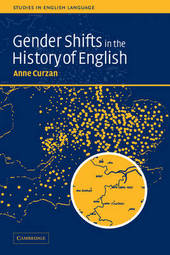
|
Gender Shifts in the History of English
Paperback / softback
Main Details
| Title |
Gender Shifts in the History of English
|
| Authors and Contributors |
By (author) Anne Curzan
|
| Series | Studies in English Language |
|---|
| Physical Properties |
| Format:Paperback / softback | | Pages:236 | | Dimensions(mm): Height 229,Width 152 |
|
| Category/Genre | Sociolinguistics
Historical and comparative linguistics |
|---|
| ISBN/Barcode |
9780521117265
|
| Classifications | Dewey:427 |
|---|
| Audience | | Professional & Vocational | |
|---|
| Illustrations |
7 Tables, unspecified; 7 Tables, unspecified
|
|
Publishing Details |
| Publisher |
Cambridge University Press
|
| Imprint |
Cambridge University Press
|
| Publication Date |
30 July 2009 |
| Publication Country |
United Kingdom
|
Description
How and why did grammatical gender, found in Old English and in other Germanic languages, gradually disappear from English and get replaced by a system where the gender of nouns and the use of personal pronouns depend on the natural gender of the referent? How is this shift related to 'irregular agreement' (such as she for ships) and 'sexist' language use (such as generic he) in Modern English, and how is the language continuing to evolve in these respects? Anne Curzan's accessibly written and carefully researched study is based on extensive corpus data, and will make a major contribution by providing a historical perspective on these often controversial questions. It will be of interest to researchers and students in history of English, historical linguistics, corpus linguistics, language and gender, and medieval studies.
Author Biography
Anne Curzan is Assistant Professor of English at the University of Michigan. She has written extensively on the history of English, lexicography, and pedagogy, and is co-author of First Day to Final Grade: A Graduate Student's Guide to Teaching (2000). Professor Curzan is also co-editor of the Journal of English Linguistics.
Reviews'This book is clearly written and accessible to undergraduates in a variety of disciplines, not just in the field of linguistics. It would also be of interest to those in the area of gender studies and mediaeval history. Each of the main analytical chapters opens with a contemporary question which contextualises the relevance of the study within Modern English footnoting elaborates points made throughout.' Journal of Sociolinguistics 'Let me just say that I wish to give it the highest possible marks for its scholarship, convincing argumentation, admirable historical insights, and exactitude. I am sure it will be a valuable textbook in a number of academic disciplines such as English, sociolinguistics, and women's studies.' Language in Society
|